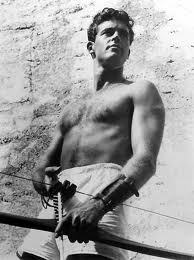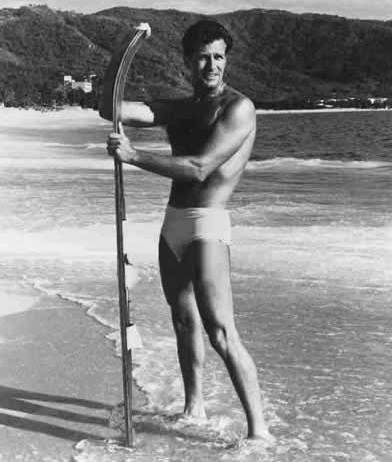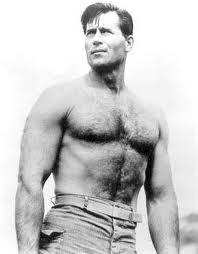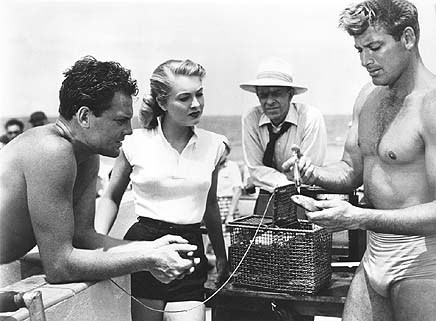
By the time I started watching TV in the 1960s, the Western was stale, outdated, staggeringly unhip; my friends and I could stomach only those few that involved a flashy new gimmick, like Wild Wild West or Alias Smith and Jones. But for the Boomers growing up in the 1950s, they were as iconic as Pinky Lee and Father Knows Best.
The Western heroes were usually the discovery of gay talent agent Henry Willson, so they were gay, bi, or at least gay-friendly. They usually wore full leather, buckskin, or other less-than-revealing garb, but they were not averse to revealing stunning physiques for the movie magazines, and even for the AMC’s proto-gay Physique Pictorial. Guy Madison (who went so far as to pose nude) in The Adventures of Wild Bill Hickock (1951-56)
Rugged movie star Hugh O’Brian in The Life and Legend of Wyatt Earp (1955-61);
Clint Walker of Cheyenne (1955-63).
William Smith of Laredo
Plus:
Richard Boone of Have Gun, Will Travel (1957-63)
Robert Horton of Wagon Train (1957-65)
Rory Calhoun of The Texan (1958-60)
George Montgomery of Cimarron City (1958-60)
Scott Brady as Shotgun Slade (1959-61)
The Western hero traditionally displayed little heterosexual interest: dames were characteristic of an emasculating civilization, along with government, education, opera, and church. Instead, they had a “sidekick,” a life partner of the same sex, usually someone of inferior rank due to race, age, or socioeconomic class, who provided an emotional or spiritual energy. The sidekick is an essentially American phenomenon, and its homoerotic import has been noted for at least thirty years, since Love and Death in the American Novel.
Most of the sidekicks of the 1950s were elderly, corpulent, or buffoons, perhaps because clowns minimze the homoerotic impact of their devotion. The fat, hee-hawking Andy Devine, later on Andy's Gang, played “Jingles,” Guy Madison’s sidekick in The Adventures of Wild Bill Hickock.
Or they were father and son, as in The Rifleman.
But we can locate several same-sex partners whose homoerotic bond was not miminized:
Indian agent Tom Jeffords (future Days of Our Lives hunk John Lumpton), who fell in love with...um, I mean befriended...handsome, muscular Chief Cochise (Michael Ansara) in Broken Arrow (1956-57).
John Bromfield as The Sheriff of Cochise (1956-60) with Stan Jones his faithful deputy.
John Smith and Robert Fuller of Laramie.
Yancy Derringer (1958-59), an ex-Confederate soldier turned gambler played by Jock Mahoney, and X Brands as his Native American companion.
Most of the sidekicks of the 1950s were elderly, corpulent, or buffoons, perhaps because clowns minimze the homoerotic impact of their devotion. The fat, hee-hawking Andy Devine, later on Andy's Gang, played “Jingles,” Guy Madison’s sidekick in The Adventures of Wild Bill Hickock.
Or they were father and son, as in The Rifleman.
But we can locate several same-sex partners whose homoerotic bond was not miminized:
Indian agent Tom Jeffords (future Days of Our Lives hunk John Lumpton), who fell in love with...um, I mean befriended...handsome, muscular Chief Cochise (Michael Ansara) in Broken Arrow (1956-57).
John Bromfield as The Sheriff of Cochise (1956-60) with Stan Jones his faithful deputy.
John Smith and Robert Fuller of Laramie.





Lone Ranger and Tonto. Batman and Robin. Dean Martin and Jerry Lewis. The list is almost endless
ReplyDeleteRobin was 10. You even have it in the Teen Titans Crisis crossover (which basically had Starfire saying that just because she's married doesn't mean they have to stop having sex, and Nightwing and Jericho start acting like a couple but DC will never admit it), Dick tells Joey it's his 20th birthday, and the tenth anniversary of his parents' deaths.
DeleteI think Robin's age varies from story to story, with the only continuity being "teenager." Sometimes he's old enough to drive a car. The sidekick can be of any age, except not so young that the relationship becomes paternal. Huckleberry Finn was 14.
DeleteHis age when his parents die has a lot to do with reboots. In the New 52, he's 16 so Batman can be younger. But in the comics at least, their relationship has always been paternal; Dick tries to set him up with Catwoman as early as the latter's first appearance. (And also tries with Talia al-Ghul post-Crisis.) Basically he neurotically tries to fill the hole left by his parents by expanding his family.
DeleteWe even see the other end of it in the Titans live-action series, where he has three kids following him...until they find out he once exploited a teenage boy's love for him to kill the kid's father, failed, and said boy was killed protecting him, and Dick felt no remorse for his actions. (To be fair, Jericho is possessing his father, just like in the comics where the Titans have a better relationship with the Terminator, but no one knows that.)
But what amuses me to no end about young Grayson is how LGBT writers (Devin Grayson, Marc Andreyko) are often the first ones to have him jump from one woman to the next, while Marv Wolfman and Chuck Dixon arguably made him demisexual, and Wolfman had fun with him and Jericho and using neutral pronouns to describe hypothetical lovers when talking to Speedy. In the late 80s.
Wait -- he had a teenage boy interested in him, then tried to kill the boy's father but ended up killing the kid instead? Holy gay subtext, Batman
DeleteI never said there wasn't gay subtext, just that Wertham interviewing a couple anonymous pedophiles wasn't sufficient evidence. And that people ignore a treasure trove of Teen Titans stuff. Which is funny, since they were the best-selling title at DC in the 80s.
DeleteSubtext varies from panels taken out of context ("Now we got two guys looking for Dick." "Joey, get in me, fast!" "Arouse Wallace so we can leave.") to easy mistakes to make. (Wonder Girl kissing Terry Long and Robin realizing why she loves him. You have to understand they look similar from the back.) to long-running arcs (mostly Jericho, and note the streaming series has Dick doing the "gay villain" tropes, but there are a few moments with Speedy and Kid Flash).
You can get a bit with the other Robins too. (Tim Drake's reaction to Superboy's death...) And Gail Simone puts lesbian subtext in Birds of Prey.
So basically the fan base thinks more than half the Bat family are bisexual, but don't you dare suggest incest.
There is one exception: A lot of the times, the Indians (really white actors in heavy bronze) just wore a loincloth, not having leggings even if it's supposedly winter.
ReplyDeleteNaturally Westerns didn't mention a winkte (basically a third gender). And while kola (sworn brothers) relationships were mentioned, exactly how close you were supposed to be was not. And they had a habit of using an African equivalent, oathing, where you let your blood mingle. And the Indians spoke mostly Papuan pidgin. And how much more weirdness?
What about The Virginian"?
ReplyDelete